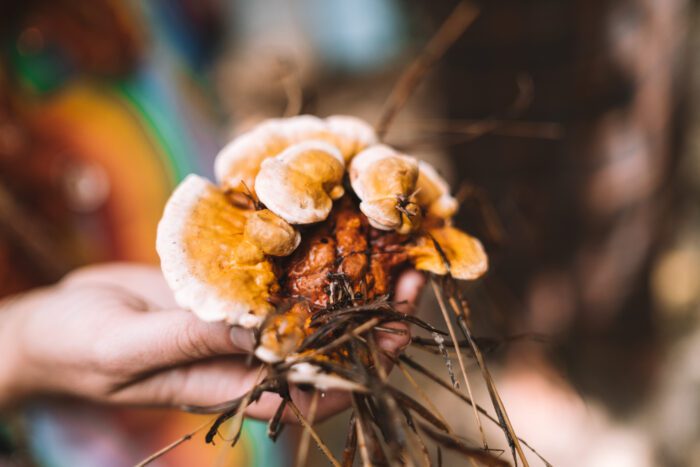Welcome to Part IV of our “How to Grow” series, where we dive into the details of cultivating mushroom species from a petri dish to the mushroom fruit body. Last week, we gave it our best for the Chestnut mushroom. This week, we wanted to take a gaze at Reishi (Ganoderma spp.), the Mushroom of Immortality! So get ready to drink from the elixir of eternal life as we learn how to grow Reishi mushrooms!
Reishi is a name used for many different species of basidiomycota mushrooms called Ganoderma. The most famous is Ganoderma lucidum, a hard, conky, saprophytic mushroom that grows from dead trees all over the world and is characterized by its beautiful, shiny skin. Heck, that’s what Ganoderma means: Gano (shining) Derma (Skin).
Some species of Reishi grow in amazing patterns akin to the Golden Ratio, like Ganoderma sessile and Ganoderma lingzhi. Then there’s the antler Reishi, Ganoderma multipileum.

Lingzhi, as Reishi is called in China, has been recognized as a medicinal mushroom for over 2,000 years. And guess what???
It’s pretty easy to learn how to grow Reishi mushrooms as a beginner and it’s an absolute sight to behold! So let’s get started!
Finding Reishi Mushroom Mycelium Cultures
The genetics of Ganoderma species can get pretty confusing! In China alone, there are around 10 Ganoderma species used in Traditional Chinese Medicine and each is considered unique in its biological activity and functions.
We even have natural Ganodermas growing on our property in Guatemala! Check them out in the video below 👇
When it comes to sourcing a Reishi culture, in our humble opinion, a great place is Terrestrial Fungi. Ryan Paul Gates is a master of Reishi culture propagation and his work should be supported! However, he only sells culture slants. If you’re looking for liquid culture syringe, we highly recommend Fungushead, and you can get 20% off storewide with code “FUNGIACADEMY”!
When you want to learn how to grow Reishi mushrooms, or any mushroom for that matter, the best way to set yourself up for success is to buy an amazing culture.
Creating Agar Dragons!
The mycelium of Ganoderma mushrooms is notoriously tough. After complete colonization, this mycelium often starts turning yellow orange-red. There is no need to panic though. This is entirely normal and not a sign of contamination.
That being said, you’ll probably need a sharp scalpel to cut it when working with an agar culture!
According to Growing Gourmet and Medicinal Mushrooms by Paul Stamets, this fungus is specifically fond of Potato Dextrose Yeast Agar (PDYA). We’ve also had lots of success using Dog Food Agar.
Unlike other fungi, Reishi mycelium doesn’t really grow radially but rather, as a flat, dense, uniform mycelial mat.
At the agar stage of learning how to grow Reishi mushrooms, the ideal incubation temperature is between 70-80°F (21-27°C).

Try our Mushroom Cultivation Course
for FREE
How to Grow Reishi Mushroom Grain Spawn
Reishi mycelium is strong and resilient, and when it encounters some sterile grains, it really shines. The type of grains you use here really doesn’t matter, though according to the low-key bible of mycology, Growing Gourmet and Medicinal Mushrooms, cereal grains are best.
The most important thing to know when learning how to grow Reishi mushrooms and their mycelium is that Reishi mycelium can become very tough.
So, if you’re like us and grow all of your grain in jars, you want to make sure it doesn’t overmature and completely encapsulate all your grains. If you let it get to this point, it becomes very difficult to remove the grain spawn from the jar.
This stage of the growing process is no different than before and the ideal incubation temperature is between 70-80°F (21-27°C).

Growing the Reishi Empire
Alright, we’re getting to the good stuff now!
Here at the Fungi Academy, we’ve grown A LOT of Reishi. And many times, it’s felt like an accident.
Before diving too deep into what our weird, accidental experiments have taught us, let’s go through the recommended channels.
Supplemented Hardwood Sawdust
By far the most popular option, supplemented hardwood sawdust is the most common method to try when you want to learn how to grow Reishi mushrooms. Though the Master Mix is a staple recipe, this high of a supplementation is not necessary for Reishi growing. In fact, between 5 and 15 percent supplementation seems to be the sweet spot. For this nitrogen supplementation, some people chose to grind up some more grains, use coffee, alfalfa, beet pulp, or oat bran. But you can use all sorts of different sources.
So now for our crazy experiments. We have successfully grown Reishi off of:
- Coco Coir 🥥
- Corn Cobs 🌽
- Pine Wood 🌲
- Other softwoods 🪓
- Straws 🌾
- Hardwood logs 🪓
We like to add about 2 percent gypsum to our substrate mixture for even higher yields.
Back to our experiments: we’ve learned that Reishi seems to do exceptionally well on only pasteurized substrates and hell, we’ve even had success fruiting them from cold water pasteurized corn cobs (completely not by accident, we promise)!
As for the Reishi kings, in China they grow Reishi from logs that are then buried beneath a few inches of soil. This method works really well, especially in humid, warm climates.
In a nutshell, when are learning how to grow Reishi mushrooms, it’s important not to hyperanalazye the process. Reishi mycelium is very forgiving and will surprise you with its tenacity!
Incubation Temperature: 70-80°F (21-27°C)
Colonization: 10 to 14 days

How to Grow Reishi Mushroom Fruits
In China, after burying the inoculated log, the farmers trim all the pins until only one remains. This creates a gigantic mushroom with, according to the farmers. ‘All of the Qi of the organism in one fruit’.
In reality, there are many different ways to grow Reishi. It can deal with high CO2 environments and adapt to grow long, antler-like fruiting bodies. Since Reishi, like other mushrooms, grow towards the light, a high Co2 environment combined with changing the direction of the given light source can create amazing artwork.
Conversely, in high O2 environments Reishi mushrooms often can grow radially into half-circle, conk-like fruits.
But while the conditions determine the fruit morphology, Reishi mushrooms aren’t picky. Forget a Reishi mushroom grow bag and you may return to find it fruiting ferociously through the filter patch on your grow bag.
Generally speaking, these are the ideal conditions to create in your fruiting room when you’re learning how to grow Reishi mushrooms.
Primordia: 64°F (18°C) at 95% humidity
Fruit Body Development: 70-80°F (21-27°C) at 85-90% humidity.
After the antlers have grown to your desired length, open or cut the bag to increase oxygen levels. Then, be patient! Reishi can take very long to mature and you can let them grow for more than 3 months before harvesting!
There you have it: how to grow Reishi mushrooms from start to finish. It’s not only a great beginner mushroom to grow. It’s also medicinal and, if you turn your fruits into extracts, a great way to turn your mushroom hobby into a profitable business.
Have you ever grown your own Reishi mushrooms? Let us know in the comments below, and tell us what mushrooms you want to learn about next in our next How to Grow series!
Looking for mushroom cultivation supplies? North Spore has an amazing selection of sterilized substrate, NocBox still air box, liquid culture multiplier, grow chambers, cultivation tools, and so much more! Use “FUNGIACADEMY” for 10% off sitewide.
about the authors
With 10+ years of mushroom growing experience and more than 2,000 students taught since 2019, Jasper has set out on a mission to make learning mushroom cultivation Easy, Fun, and Exciting!
This Myconaut did not fit in the traditional academic system, AT ALL. Yet, his thirst for knowledge carried him on a path of life-long learning. With the skillset of a self-taught teacher, he aims to make the art and science of mushroom cultivation accessible to everyone aspiring to be a citizen mycologist.


Sam is a writer, award-winning journalist and professional mycologist from the United States who arrived at the Fungi Academy one midsummer’s day in 2019 and left six weeks later with lifelong friends and a passion for mushroom cultivation.
In the past year three years, he’s built a laboratory and fruiting room in his home, cultivated and foraged over 20 species of gourmet and medicinal mushrooms, started a medicinal mushroom tincture business and returned to the Fungi Academy to teach his techniques to students.

